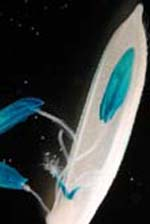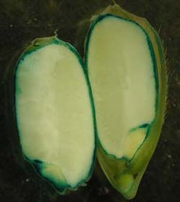
GUS reporter system
Encyclopedia

Reporter gene
In molecular biology, a reporter gene is a gene that researchers attach to a regulatory sequence of another gene of interest in cell culture, animals or plants. Certain genes are chosen as reporters because the characteristics they confer on organisms expressing them are easily identified and...
system, particularly useful in plant molecular biology
Molecular biology
Molecular biology is the branch of biology that deals with the molecular basis of biological activity. This field overlaps with other areas of biology and chemistry, particularly genetics and biochemistry...
. Several kinds of GUS reporter gene assay are actually available, depending on the substrate used. The term GUS staining refers to the most common of these, a histochemical technique.
Purpose
The purpose of this technique is to analyze the activity of a promoter (in terms of expressionGene expression
Gene expression is the process by which information from a gene is used in the synthesis of a functional gene product. These products are often proteins, but in non-protein coding genes such as ribosomal RNA , transfer RNA or small nuclear RNA genes, the product is a functional RNA...
of a gene under that promoter) either in a quantitative way or through visualization of its activity in different tissues
Biological tissue
Tissue is a cellular organizational level intermediate between cells and a complete organism. A tissue is an ensemble of cells, not necessarily identical, but from the same origin, that together carry out a specific function. These are called tissues because of their identical functioning...
. The technique is based on beta-glucuronidase, an enzyme from the bacterium Escherichia coli
Escherichia coli
Escherichia coli is a Gram-negative, rod-shaped bacterium that is commonly found in the lower intestine of warm-blooded organisms . Most E. coli strains are harmless, but some serotypes can cause serious food poisoning in humans, and are occasionally responsible for product recalls...
; this enzyme, when incubated with some specific colorless or non-fluorescent substrate
Substrate (biology)
In biology a substrate is the surface a plant or animal lives upon and grows on. A substrate can include biotic or abiotic materials and animals. For example, encrusting algae that lives on a rock can be substrate for another animal that lives on top of the algae. See also substrate .-External...
s, can transform them into coloured
Color
Color or colour is the visual perceptual property corresponding in humans to the categories called red, green, blue and others. Color derives from the spectrum of light interacting in the eye with the spectral sensitivities of the light receptors...
or fluorescent
Fluorescence
Fluorescence is the emission of light by a substance that has absorbed light or other electromagnetic radiation of a different wavelength. It is a form of luminescence. In most cases, emitted light has a longer wavelength, and therefore lower energy, than the absorbed radiation...
products.
Substrates
There are actually different possible glucuronideGlucuronide
A glucuronide, also known as glucuronoside, is any substance produced by linking glucuronic acid to another substance via a glycosidic bond...
s that can be used as substrates for the beta-glucuronidase, depending on the type of detection needed (histochemical
Histology
Histology is the study of the microscopic anatomy of cells and tissues of plants and animals. It is performed by examining cells and tissues commonly by sectioning and staining; followed by examination under a light microscope or electron microscope...
, spectrophotometrical, fluorimetrical). The most common substrate for GUS histochemical staining is 5-bromo-4-chloro-3-indolyl glucuronide (X-Gluc): the product of the reaction is in this case a clear blue color. Other common substrates are p-nitrophenyl β-D-glucuronide for the spectrophotometrical assay and 4-methylumbelliferyl-beta-D-glucuronide (MUG) for the fluorimetrical assay.
History
The system was originally developed by Richard Anthony JeffersonRichard Anthony Jefferson
Richard Anthony Jefferson is an American-born molecular biologist, who developed the reporter gene system GUS, a widespread molecular technique...
during his Ph.D.
Ph.D.
A Ph.D. is a Doctor of Philosophy, an academic degree.Ph.D. may also refer to:* Ph.D. , a 1980s British group*Piled Higher and Deeper, a web comic strip*PhD: Phantasy Degree, a Korean comic series* PhD Docbook renderer, an XML renderer...
at the University of Colorado at Boulder
University of Colorado at Boulder
The University of Colorado Boulder is a public research university located in Boulder, Colorado...
. He adapted the technique for the use with plants as he worked in the Plant Breeding Institute of Cambridge
Cambridge
The city of Cambridge is a university town and the administrative centre of the county of Cambridgeshire, England. It lies in East Anglia about north of London. Cambridge is at the heart of the high-technology centre known as Silicon Fen – a play on Silicon Valley and the fens surrounding the...
, between 1985 and 1987 . Since then thousands of labs have used the system, making it probably the most widely used tool in plant molecular biology, as underlined by over 6000 citations in scientific literature.
Target organisms

Spermatophyte
The spermatophytes comprise those plants that produce seeds. They are a subset of the embryophytes or land plants...
, mosses, algae
Algae
Algae are a large and diverse group of simple, typically autotrophic organisms, ranging from unicellular to multicellular forms, such as the giant kelps that grow to 65 meters in length. They are photosynthetic like plants, and "simple" because their tissues are not organized into the many...
, fern
Fern
A fern is any one of a group of about 12,000 species of plants belonging to the botanical group known as Pteridophyta. Unlike mosses, they have xylem and phloem . They have stems, leaves, and roots like other vascular plants...
s, fungi and most bacteria
Bacteria
Bacteria are a large domain of prokaryotic microorganisms. Typically a few micrometres in length, bacteria have a wide range of shapes, ranging from spheres to rods and spirals...
, the assay is perfectly suited for these organisms. Thus it is used widely in plant science.
Other reporter systems
The GUS system is not the only available gene reporter system for the analysis of promoter activity. Other competing systems are based on e.g. luciferaseLuciferase
Luciferase is a generic term for the class of oxidative enzymes used in bioluminescence and is distinct from a photoprotein. One famous example is the firefly luciferase from the firefly Photinus pyralis. "Firefly luciferase" as a laboratory reagent usually refers to P...
, GFP
Green fluorescent protein
The green fluorescent protein is a protein composed of 238 amino acid residues that exhibits bright green fluorescence when exposed to blue light. Although many other marine organisms have similar green fluorescent proteins, GFP traditionally refers to the protein first isolated from the...
, beta-galactosidase
Beta-galactosidase
β-galactosidase, also called beta-gal or β-gal, is a hydrolase enzyme that catalyzes the hydrolysis of β-galactosides into monosaccharides. Substrates of different β-galactosidases include ganglioside GM1, lactosylceramides, lactose, and various glycoproteins...
, chloramphenicol acetyltransferase
Chloramphenicol acetyltransferase
Chloramphenicol acetyltransferase is a bacterial enzyme that detoxifies the antibiotic chloramphenicol and is responsible for chloramphenicol resistance in bacteria. This enzyme covalently attaches an acetyl group from acetyl-CoA to chloramphenicol, which prevents chloramphenicol from binding to...
(CAT), alkaline phosphatase
Alkaline phosphatase
Alkaline phosphatase is a hydrolase enzyme responsible for removing phosphate groups from many types of molecules, including nucleotides, proteins, and alkaloids. The process of removing the phosphate group is called dephosphorylation...
. The use of one or the other system is mainly dependent on the organism of interest.
Other uses


